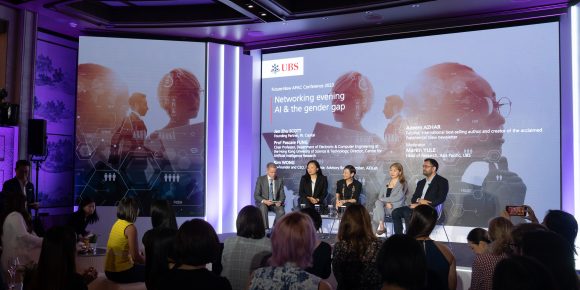
Among the many and varied positive outcomes expected from an ever-wider application of AI, there is increasing optimism that it will help promote greater gender equality in the workplace.
The gender divide continues to be quite stark in many industries, despite efforts to drive more diversity in recent years. For example, said session moderator Martin Yule, Head of Research, Asia Pacific at UBS, only just over a quarter of entrants into the science, technology, engineering and maths industries are female, with a similarly low proportion represented in the finance sector.
However, AI can help address such inequalities, according to Prof Pascale Fung, Chair Professor, Department of Electronic & Computer Engineering at the Hong Kong University of Science & Technology (HKUST).
“We see an increasing number of women entering the world of AI. They tend to care more about the benefits of technology and about being involved with AI for mitigating any potential harm it might create,” explained Fung, who is also a Director at the Centre for Artificial Intelligence Research.
Women tend to care more about the benefits of technology and about being involved with AI for mitigating any potential harm.
A powerful aspect of generative AI is that it lowers the entry barrier.
Better opportunities
Better opportunities
As a growing number of women – especially younger ones – become more interested in AI, they will derive further benefits if they empower themselves to learn the new associated tools.
Jen Zhu Scott, Founding Partner of IN. Capital, believes this is essential in enabling AI to become a new opportunity for more women. “A powerful aspect of generative AI is that it lowers the entry barrier to interacting with the tool.”
For Kim Wong, Co-Founder and Chief Executive Officer of Code-Create, this is happening in the fashion industry, which is increasingly using AI to transform the ecosystem to make it more sustainable.
“AI can give us the data to help with our planning and inspiration, by better understanding different markets and changing consumer behaviour, so we can be more creative, and in a focused way,” said Wong, who is also an Advisory Board Member at AiDLab.
More broadly, Fung believes that women might be more likely than men to embrace AI for certain purposes.
She cited the example of using AI-powered technologies to take better care of young as well as elderly people. “These are issues which resonate more with women. This opportunity empowers women to help shape the algorithms to have a positive influence.”
Measured progress
Measured progress
At the same time, there might be instances initially where AI won’t directly achieve the goal of bridging the diversity gap.
This might happen where the focus of generative tools is to enhance productivity for certain types of office work.
For example, one of the most immediate uses for large language models is improving automated customer service feedback, explained Azeem Azhar, Futurist and international best-selling author, as well as the Founder of the Exponential View newsletter. Yet the job of customer service representatives is typically skewed towards women, he added. “This makes it one of the most exposed professions to the impact of AI.”
On the flipside, while data suggests future generative AI will affect higher paid and more specialist roles within companies, Azhar said that these workers offer a strategic value-add to their firms, plus their employers invest more heavily in their development. As a result, even if the technology could be rolled out very quickly, he believes it might happen more slowly than some people think.
Ultimately, there is general optimism around the positive impacts that AI will have on the gender issue.
Fung also observes a big diversity and inclusion push within the research labs at big AI and tech companies to hire more women. “I am encouraged that our future will be gender balanced,” she added.

